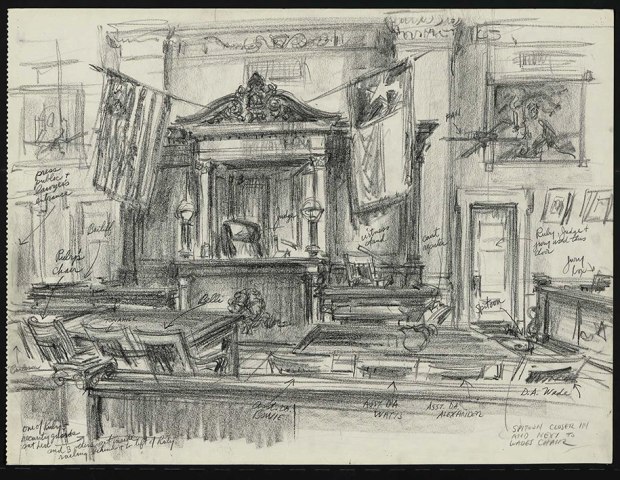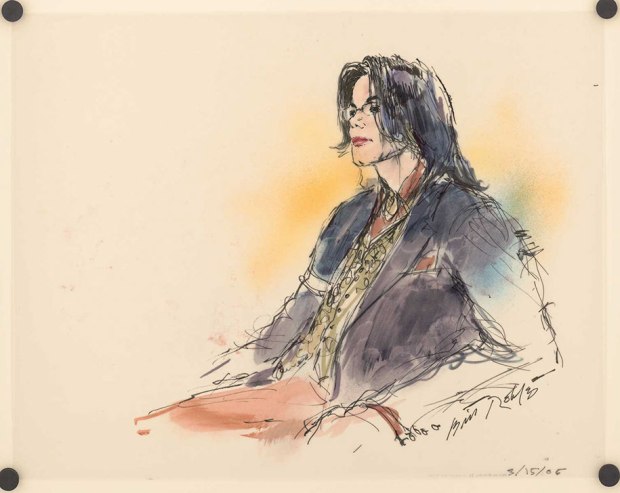
Sketch artists were and are often used in court cases, especially in those were no media is allowed.
Below are some examples of court sketches from some very famous cases.
All White Jury Frees Klan Members,By Howard Brodie

Civil rights activist Viola Liuzzo was shot and killed on March 25, 1965, as she drove African American civil rights marcher Leroy Moton in her car from Montgomery to Selma, Alabama. Four Ku Klux Klan members, Eugene Thomas, William Eaton, Collie Leroy Wilkins, Jr., and Thomas Rowe, Jr., were arrested and tried. Artist Howard Brodie drew the all-white, all-male jury that served at one of the multiple trials. While Rowe, an FBI informant, received immunity for his testimony, Thomas, Eaton and Wilkins, were acquitted in state trials. On December 3, 1965, the three men received ten-year sentences on a federal charge of conspiracy to deprive Liuzzo of her civil rights. As a result of Liuzzo’s death, President Johnson petitioned Congress to increase the scope of the Federal Conspiracy Act of 1870 to include the death of civil rights workers. Her death also helped raise support for the passage of the Voting Rights Act, Pub. L. 89-110.

Law Suits against Cigarette Manufacturers,By Marilyn Church

Donald J. Cohn of Webster & Sheffield, a cigarette manufacturer’s counsel, is shown speaking to the jury in Cipollone v. Liggett Group, Inc., 683 F.Supp. 1487 (1988), in U.S. District Court D in New Jersey. Presiding Judge H. Lee Sarokin agreed with the defendants that affixing to their product the Surgeon General’s warning that cigarette smoking is dangerous to one’s health fulfilled the minimum requirement for cigarette manufacturers and that the plaintiff’s lawyers could not argue based on the advertiser’s implications that lower nicotine content is safer. Rose Cipollone had died but her family argued it up to the U.S. Supreme Court. The Cipollones lost their case, but the justices ruled during litigation that smokers might have other grounds to pursue claims against cigarette manufacturers under state laws.
O. J. Simpson Civil Trial,by Bill Robles

Unlike his well-publicized criminal trial, which was broadcast on television, O.J. Simpson’s civil trial was a quieter affair. Bill Robles drew the former football star during the civil court case on a day in which several witnesses elaborated on his late ex-wife’s attempts to end his stalking. When Simpson was ordered to pay $33.5 million to the families of Nicole Simpson and Ron Goldman, he claimed to be broke and so they received comparatively little.
Larry Flynt vs Jerry Falwell,By Aggie Kenny

Publisher Larry Flynt provoked a lawsuit for damages for satirizing televangelist Jerry Falwell in a fake Campari ad in Hustler magazine. The U.S. Supreme Court unanimously agreed in Hustler v. Falwell, 485 U.S. 46 (1988), that a parody, which no reasonable person expected to be true, was protected free speech. The justices also stated that upholding the lower courts’ decisions would put all political satire at risk. Alan Isaacman defended Flynt before eight justices, as Justice Anthony Kennedy recused himself. Flynt (in a wheelchair) is isolated due to an outburst during a previous Supreme Court appearance in another libel case.
Helter Skelter,By Bill Robles

In the more than nine months that Charles Manson was on trial for the murders of Sharon Tate and Leno and Rosemary LaBianca, he grew increasingly agitated. On October 5, 1970, he quickly leaped from the defense table, pencil in hand, preparing to stab Justice Charles H. Older. Bill Robles captured Manson’s frenzied energy, which seemingly required all the might of the burly bailiff to restrain him. The pencil, still in motion, flies through the air toward the judge. By all accounts, Older did not even flinch. Walter Cronkite led off CBS Evening News that night with Robles’s drawing.
Trial of Michael Jackson,By Bill Robles

In 2005, Michael Jackson faced trial in Santa Monica, California, on charges of molesting a teenager. He was found not guilty. After the trial Jackson said, “I haven’t been betrayed or deceived by children. Adults have let me down.” Artist Bill Robles found drawing at the trial a challenge—he endured the “Melville diet” named after Judge Rodney Melville who scheduled only three ten-minute breaks and no lunch. Robles had barely enough time to meet the network news truck to film his drawings before returning inside to draw again.
Son of Sam,By Joseph Papin

David Berkowitz had terrorized New York City for a year, killing and injuring young couples out late at night and sending letters from the “Son of Sam” to New York Daily News columnist Jimmy Breslin before he was captured. Appearing in court on May 22, 1978, for sentencing, Berkowitz exploded in the courtroom, shouting, “I’ll kill them all,” as guards escorted him out. The judge delayed his sentencing until June 12, when he was much calmer. Rather than face a jury trial, Berkowitz pled guilty. Joseph Papin’s drawing, which captured the criminal’s anguished mental breakdown so vividly, appeared on the cover of the New York Daily News.

Donation
I am passionate about my site and I know you all like reading my blogs. I have been doing this at no cost and will continue to do so. All I ask is for a voluntary donation of $2, however if you are not in a position to do so I can fully understand, maybe next time then. Thank you. To donate click on the credit/debit card icon of the card you will use. If you want to donate more then $2 just add a higher number in the box left from the PayPal link. Many thanks.
$2.00
You must be logged in to post a comment.